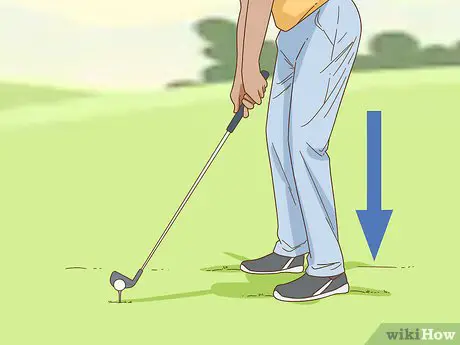Picking The Right Shaft For Your Driver

When it comes to optimizing your performance on the golf course, choosing the right shaft for your driver is a critical decision. The shaft is the engine of your club, translating the power and energy generated by your swing into distance, accuracy, and control. With a vast array of options available, finding the perfect shaft can seem like a daunting task. However, by understanding the key factors and considerations involved, you can unlock your true potential off the tee.
In this comprehensive guide, we will delve into the art and science of picking the right shaft for your driver. We’ll explore the various elements that contribute to shaft performance, including flex, weight, material, torque, kick point, and more. By the end, you’ll have the knowledge and confidence to make an informed decision that suits your unique swing characteristics and helps you achieve your desired ball flight.
Whether you’re a seasoned golfer looking to fine-tune your equipment or a beginner seeking the best foundation for your game, this guide will provide you with the insights and guidance needed to select a driver shaft that enhances your distance, accuracy, and overall enjoyment on the course.
Get ready to dive into the world of shaft selection and embark on a journey toward unleashing your full potential off the tee!

Understanding Golf Club Shafts
Before diving into the specifics of shaft selection, it’s essential to understand the basics of golf club shafts. The shaft is the long, tubular component of the golf club that connects the grip to the clubhead. It plays a vital role in transmitting the energy generated by your swing to the ball, affecting both distance and accuracy.
Components and Construction of a Shaft
A golf club shaft consists of several components that work together to provide the desired performance characteristics. These components include:
- Shaft Material: Shafts are typically made from graphite or steel, each with its unique properties and advantages.
- Shaft Flex: The flexibility of the shaft determines how it bends during the swing and affects the timing and release of the clubhead.
- Shaft Weight: The weight of the shaft influences the overall feel of the club, swing tempo, and the ability to generate power.
- Shaft Torque and Kick Point: Torque refers to the amount of twisting the shaft undergoes during the swing, while kick point refers to the location on the shaft where it flexes the most.
By understanding these components and their impact on your swing and performance, you can make informed decisions when choosing a shaft for your driver.
Determining Your Swing Speed and Tempo
One of the first steps in selecting the right shaft for your driver is understanding your swing speed and tempo. These two factors play a crucial role in determining the optimal shaft characteristics for your game.
Why swing speed and tempo matter for shaft selection
Swing speed refers to the speed at which the clubhead is traveling just before impact. It is a fundamental factor in determining the ideal shaft flex and weight for your driver. A shaft that matches your swing speed allows for efficient energy transfer and optimal performance.
Tempo, on the other hand, refers to the rhythm and timing of your swing. It is a subjective aspect of your swing style and can influence the overall feel and performance of the shaft. Matching the tempo of your swing with the right shaft can lead to better control and consistency.
How to measure swing speed accurately
To measure your swing speed accurately, several methods can be employed. The most common way is to use a launch monitor or have a professional club fitting session. These tools provide accurate data on your swing speed, allowing you to make more informed decisions when selecting a shaft.
Additionally, some driving ranges offer swing speed radar devices or even smartphone apps that can provide rough estimates of your swing speed.
Assessing your swing tempo and its impact on shaft selection
Assessing your swing tempo involves understanding the pace and timing of your swing. Are you more deliberate and smooth, or do you have a quick and aggressive tempo? This evaluation helps determine the appropriate flex and feel that will suit your swing style.
Tempo can be subjective, but observing your swing and seeking feedback from a golf instructor or experienced players can provide valuable insights into your swing tempo and guide your shaft selection.
Shaft Flex: Finding the Right Level of Flexibility
Shaft flex is a critical factor in optimizing your driver performance. It refers to the amount of bend or flex the shaft exhibits during the swing. The flex of a shaft influences the timing of your release, the trajectory of your shots, and the overall feel of the club.
What is shaft flex and why is it important?
Shaft flex refers to the degree to which a shaft bends when force is applied during the swing. It affects the timing of your release, which is the point at which the clubhead catches up with your hands and strikes the ball. Choosing the appropriate flex ensures that the clubhead is in the optimal position at impact for maximum distance and accuracy.
Identifying the appropriate flex for your swing speed and tempo
To determine the right flex for your driver, you need to consider your swing speed and tempo. Generally, the following guidelines can be helpful:
- Regular Flex: Suitable for golfers with a swing speed around 85-95 mph. This flex provides a good balance of control and distance for a wide range of players.
- Stiff Flex: Recommended for golfers with a swing speed of 95-105 mph. A stiffer flex helps maintain control and prevents the shaft from feeling too whippy during the downswing.
- Extra Stiff Flex: Designed for players with a swing speed exceeding 105 mph. This flex offers maximum control and stability, allowing for powerful drives with lower trajectory.
Keep in mind that these recommendations may vary depending on your tempo and swing characteristics. It’s crucial to test different flex options to find the one that feels most comfortable and optimizes your ball flight.
Exploring the different flex options (regular, stiff, senior, etc.)
Beyond the basic flex categories of regular, stiff, and extra stiff, there are other flex options available to cater to different swing speeds and player preferences. These include:
- Senior Flex: Designed for golfers with slower swing speeds (typically below 85 mph). The senior flex offers added flexibility and helps generate more clubhead speed for increased distance.
- Ladies Flex: Specifically designed for women golfers with slower swing speeds. The ladies flex provides additional flex to maximize distance and control.
It’s important to note that the terminology and classifications of flex may vary slightly between manufacturers. When considering different flex options, it’s recommended to test clubs with various flexes to determine the best fit for your game.
Shaft Weight: Balancing Power and Control
Shaft weight is another crucial aspect to consider when selecting the right shaft for your driver. The weight of the shaft affects your swing tempo, clubhead speed, and the overall feel of the club.
Understanding the significance of shaft weight in driver performance
The weight of the shaft directly impacts the balance and overall weight of the club. A lighter shaft can increase clubhead speed, resulting in potential distance gains. On the other hand, a heavier shaft can provide added stability and control, allowing for better shot shaping and accuracy.
Factors influencing the choice of shaft weight
When determining the ideal shaft weight for your driver, consider the following factors:
- Player Strength and Swing Characteristics: Golfers with greater strength and faster swings may benefit from a heavier shaft to help control the club and maintain consistency. Players with slower swings may find a lighter shaft helps generate more clubhead speed.
- Swing Tempo: Your swing tempo plays a significant role in choosing the right shaft weight. Faster swing tempos may benefit from a slightly heavier shaft to maintain control, while slower swing tempos may benefit from a lighter shaft to help generate more clubhead speed.
It’s important to find the right balance between power and control when selecting the shaft weight that suits your game. Testing different shaft weights and evaluating their impact on your ball flight and overall feel can provide valuable insights into finding the optimal weight for your driver.
Shaft Material: Comparing Graphite and Steel
The material of the shaft can significantly influence the performance and feel of your driver. The two most common materials for golf club shafts are graphite and steel, each offering distinct advantages and characteristics.
Overview of graphite and steel shafts
Graphite Shafts:
- Graphite shafts are lighter in weight compared to steel shafts, making them ideal for golfers looking to increase clubhead speed and maximize distance.
- They offer increased flexibility, resulting in a softer feel and potentially higher launch angles.
- Graphite shafts can help reduce vibrations and dampen harsh impacts, providing a more comfortable experience for players with joint or hand sensitivity.
- These shafts are particularly beneficial for players with slower swing speeds or those seeking additional forgiveness and distance.
Steel Shafts:
- Steel shafts are generally heavier and offer more rigidity compared to graphite shafts.
- They provide excellent control and stability, making them popular among golfers with faster swing speeds or those who prioritize accuracy and shot shaping.
- Steel shafts have a firmer feel and provide better feedback on impact, allowing players to gauge the quality of their strikes more accurately.
- These shafts are known for their durability and longevity, making them a preferred choice for players who put their clubs through rigorous use.
Advantages and disadvantages of graphite shafts
Graphite shafts offer several advantages, including increased distance, lighter weight, and improved comfort. However, they also have some potential drawbacks, such as reduced control and a higher price point compared to steel shafts. It’s important to consider your swing characteristics, playing style, and personal preferences when deciding whether graphite shafts are the right fit for your driver.
Advantages and disadvantages of steel shafts
Steel shafts provide exceptional control, stability, and a firm feel, making them popular among skilled golfers and those who prioritize accuracy. However, they may feel heavier to some players and may not generate as much clubhead speed as graphite shafts. Steel shafts are typically more affordable and offer increased durability, making them an excellent choice for golfers who prefer a solid and consistent feel.
When choosing between graphite and steel shafts, it’s essential to consider your swing speed, desired ball flight, control requirements, and personal preferences. Testing both options can provide valuable insights into which material best suits your game.
Torque and Kick Point: Fine-tuning Shaft Performance
In addition to shaft flex and material, two other crucial factors that influence shaft performance are torque and kick point. Understanding these concepts and their effects on ball flight and feel can help you further refine your shaft selection.
Explaining torque and its impact on clubface control and shot dispersion
Torque refers to the amount of twisting or rotational force that a shaft experiences during the swing. It is measured in degrees and represents how much the shaft rotates when subjected to a given force. Higher torque means the shaft twists more, while lower torque indicates less twisting.
The amount of torque can affect clubface control and shot dispersion. Shafts with lower torque generally provide better clubface stability and control, resulting in reduced shot dispersion. Higher torque shafts, on the other hand, can offer increased forgiveness and help players achieve higher launch angles.
Understanding the impact of kick point on launch angle and trajectory
Kick point, also known as bend point or flex point, refers to the specific location along the shaft where it flexes the most during the swing. Different kick point positions can influence the launch angle and trajectory of your shots.
- Low Kick Point: A shaft with a low kick point flexes near the clubhead, resulting in a lower launch angle and potentially a more penetrating ball flight. This can be advantageous for players seeking a flatter, more controlled trajectory.
- High Kick Point: A shaft with a high kick point flexes closer to the grip end of the shaft. This leads to a higher launch angle and a potentially higher ball flight. Golfers looking for increased carry distance and a steeper descent angle may benefit from a shaft with a higher kick point.
Finding the ideal torque and kick point for your swing requires experimentation and testing. Factors such as swing speed, tempo, and desired ball flight should guide your decision. Working with a professional club fitter or seeking expert advice can help you determine the optimal torque and kick point for your driver shaft.
Considering Shaft Length and Grip Combination
While shaft flex, weight, material, and other factors play crucial roles in choosing the right shaft for your driver, the length of the shaft and the grip combination also warrant careful consideration.
The relationship between shaft length and distance control
The length of the shaft can impact both distance and control. A longer shaft has the potential to generate more clubhead speed, leading to increased distance. However, it may also be more challenging to control and can affect the consistency of your strikes.
Conversely, a shorter shaft may offer enhanced control and accuracy, but it could sacrifice some potential distance. Finding the right balance between distance and control is essential, and it often comes down to personal preference and swing characteristics.
Custom fitting and the role of grip size and texture
Custom fitting, including grip fitting, is an integral part of selecting the right shaft for your driver. The grip is the only point of contact between you and the club, making it crucial to ensure a comfortable and secure grip.
Grip size plays a significant role in hand placement and control. Golfers with larger hands may opt for larger grips to minimize excessive hand action, while those with smaller hands may benefit from smaller grips to enhance feel and control.
Grip texture is another consideration. Some golfers prefer a softer, tackier grip for increased comfort and grip stability, while others may prefer a firmer grip for improved feedback and shot control.
A professional club fitting session can help determine the appropriate shaft length and grip size and texture that suit your swing characteristics and enhance your overall performance.
Seeking Professional Guidance: Getting Fitted for the Right Shaft
With the multitude of options available, selecting the perfect shaft for your driver can be a daunting task. That’s where professional club fitting comes in. Seeking guidance from a qualified club fitter or PGA professional can provide invaluable insights and ensure that you make an informed decision.
During a fitting session, your swing mechanics, launch monitor data, and personal preferences will be analyzed. The fitter will consider factors such as swing speed, tempo, ball flight, and shot tendencies to recommend suitable shaft options tailored to your specific needs.
Remember, a proper fitting session takes into account not only the technical aspects but also your comfort and confidence with the chosen shaft. It’s an investment that can lead to improved performance, consistency, and enjoyment on the golf course.
Testing and Evaluating Shafts: Trial and Error
While professional club fitting provides an excellent starting point, testing and evaluating different shaft options is crucial in finding the perfect fit for your game. Testing allows you to experience firsthand how different shafts perform and feel, helping you make an informed decision.
When testing shafts, consider the following tips:
- Use a consistent swing: Maintain a consistent swing tempo and rhythm to ensure accurate comparisons between different shafts.
- Pay attention to feel: Assess how each shaft feels during the swing and at impact. Look for a shaft that provides the desired feedback and a comfortable sensation.
- Evaluate ball flight: Observe the launch angle, spin rates, and shot dispersion with each shaft. Look for a consistent and desirable ball flight pattern.
- Compare distance and accuracy: Assess both distance and accuracy to find the optimal combination that suits your game.
By testing and evaluating shafts, you can gather valuable data and insights about their performance and how they suit your swing characteristics. Keep in mind that the “right” shaft may vary from player to player, so it’s essential to trust your own experience and preferences during the testing process.
Additionally, some golf retailers and manufacturers offer fitting carts or demo days where you can try out various shaft options on the driving range or indoor simulator. Take advantage of these opportunities to gain a better understanding of how different shafts perform with your driver.
Maintenance and Upgrades: Revisiting Shaft Choices Over Time
Once you’ve selected the right shaft for your driver, it’s essential to maintain its performance and reassess your choice over time. Factors such as changes in your swing, improvements in your game, or advancements in shaft technology may warrant a reevaluation of your shaft selection.
Regularly inspect your shaft for any signs of wear, such as cracks, dents, or corrosion. Additionally, consider reviewing your swing characteristics periodically to ensure that the chosen shaft still aligns with your swing speed, tempo, and overall playing style.
If you notice any significant changes or feel that your current shaft is no longer optimal for your game, don’t hesitate to seek professional guidance and consider the possibility of upgrading or changing your shaft.
Conclusion
Choosing the right shaft for your driver is a crucial step towards maximizing your potential on the golf course. The combination of flex, weight, material, torque, kick point, length, and grip can significantly impact your swing mechanics, ball flight, and overall performance.
Remember that there is no one-size-fits-all solution when it comes to shaft selection. Each golfer is unique, with varying swing characteristics, preferences, and goals. Professional club fitting, coupled with thorough testing and evaluation, will help you find the shaft that best suits your individual needs and unlocks your true potential off the tee.
Investing time and effort into understanding the intricacies of shaft selection and working with knowledgeable experts will ultimately lead to improved distance, accuracy, and consistency with your driver. Enjoy the journey of finding the perfect shaft, and watch as your drives soar down the fairway with confidence and precision.






